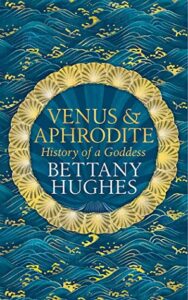 Venus & Aphrodite, Bettany Hughes
Venus & Aphrodite, Bettany Hughes
This looks more substantial on the shelf than it actually is; I read it in about 90 minutes, though it’ll take more time to follow up on some of the things I’m interested in and maybe follow up some of the bibliography. It’s a sort of biography of the goddess, from her origins as Ishtar through to her afterlife as Venus in the world of razors and the silver screen. It’s not that there’s nothing new to me here, but it feels like without the chapter breaks and introductory quotes and images and rather spaced out text, it would be a much slimmer book.
However, I did learn some interesting things; I hadn’t known, for example, that Astarte and Aphrodite were so strongly linked on Cyprus (I thought it was a bit more vague), and I definitely didn’t know about the female-bodied bearded versions of Aphrodite. Elsewhere those images do seem to be interpreted as referring to Hermaphroditus rather than Aphrodite, but the descent from Astarte sort of suggests that as being a later development, perhaps as Aphrodite became more and more an object of desire instead of the powerful, war-linked goddess she was as Astarte. Hughes definitely describes the statues as definitively being of Aphrodite-Aphroditos, at least. I’d love to see more clarification on that, but the chapter on this was so short.
Enjoyable, then, and an easy read, but not very in-depth.

Having visited Cyprus several times way back in the day, I knew there was a very strong connection there to Aphrodite, and a few temples too. There’s supposed to be a hidden grotto too dedicated to her.
Oh, I think I was unclear — I knew Aphrodite originated from Cyprus, both in legend and in terms of that being where the myth grew up. I hadn’t realised that the Phoenician goddess Astarte was linked so closely with her on Cyprus specifically — I thought the connection was a bit more vague.